Hopi Pueblo Polychrome Small Jar by Tonita Hamilton Nampeyo - C4047K
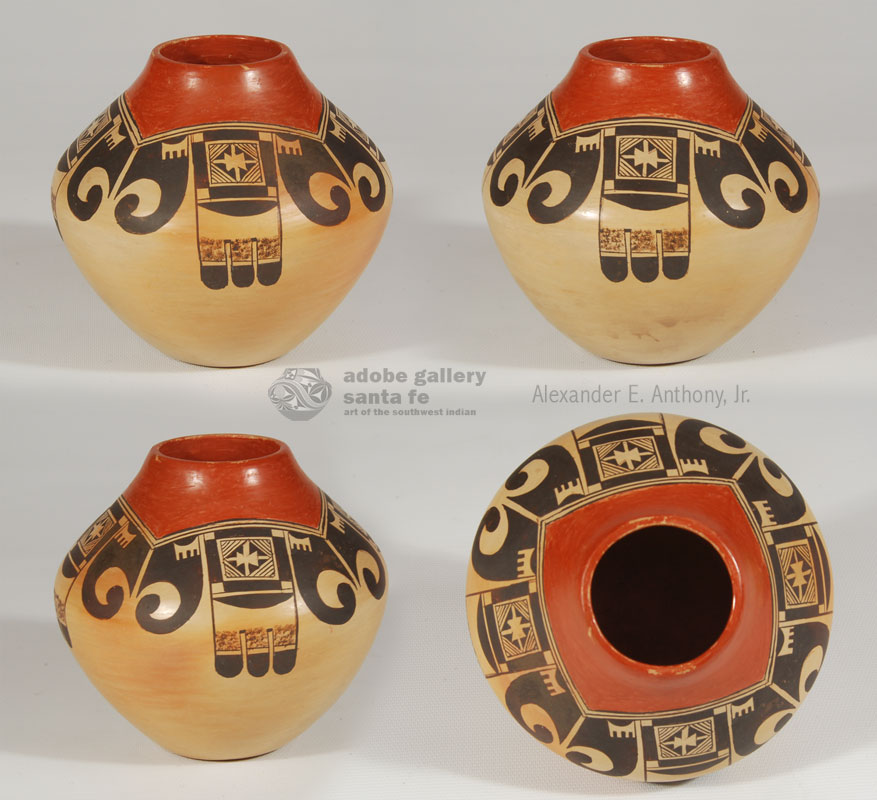 Following in the tradition of Nampeyo of Hano, many of her children and grandchildren and following generations of potters have used the designs of the prehistoric Sikyatkiancestors of the Hopi. Nampeyo is known for re-introducing those designs at the turn of the last century, so we see that those designs have had a second reincarnation that is now over a hundred years old.
Following in the tradition of Nampeyo of Hano, many of her children and grandchildren and following generations of potters have used the designs of the prehistoric Sikyatkiancestors of the Hopi. Nampeyo is known for re-introducing those designs at the turn of the last century, so we see that those designs have had a second reincarnation that is now over a hundred years old.
The design on this small jar by Tonita Hamilton Nampeyo (1934 - present) is referred to as the Eagle Tail design. It is not known who gave names to these reused designs from a thousand years ago, but probably early traders are responsible.
To purchase or read more click here..
#adobegallery #SouthwestIndianPottery #HopiPueblo #PuebloPottery #SantaFePottery #FinePuebloPottery #SantaFeNM #TonitaNampeyo
Large Polychrome Hopi Pueblo Seed Jar by Mark Tahbo - C4047A
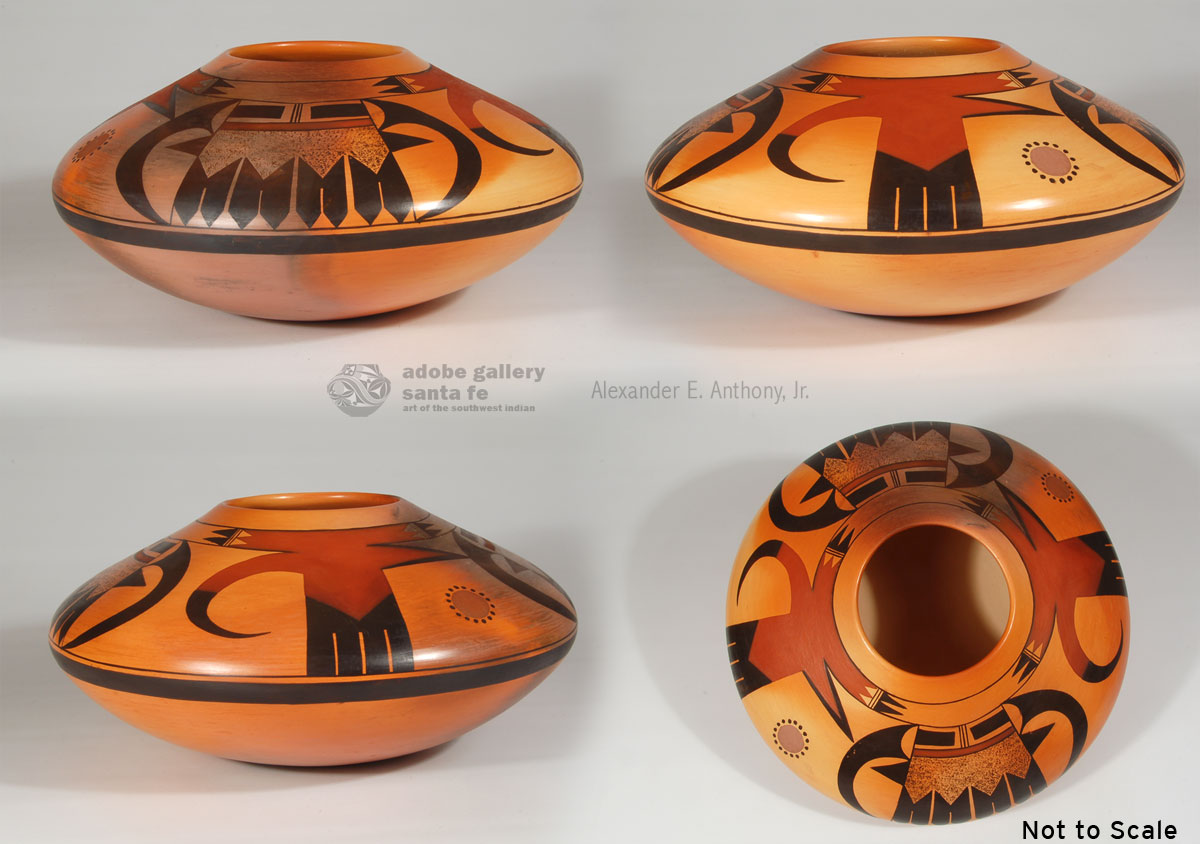 Mark Tahbo (1958-2017) was a Hopi-Tewa potter who descended from a long line of talented artists. He learned the art of pottery making from his great grandmother, Hopi legend Grace Chapella. A true traditionalist whose work and life were informed by those of his ancestors, Tahbo's thin-walled, perfectly painted vessels were always crafted using traditional methods and Native materials. Mark received numerous awards from many of the significant Native art events, including Best of Division at the 1992 Heard Museum Indian Fair and Overall Prize at the 1991 Santa Fe Indian Market.
Mark Tahbo (1958-2017) was a Hopi-Tewa potter who descended from a long line of talented artists. He learned the art of pottery making from his great grandmother, Hopi legend Grace Chapella. A true traditionalist whose work and life were informed by those of his ancestors, Tahbo's thin-walled, perfectly painted vessels were always crafted using traditional methods and Native materials. Mark received numerous awards from many of the significant Native art events, including Best of Division at the 1992 Heard Museum Indian Fair and Overall Prize at the 1991 Santa Fe Indian Market.
To purchase or read more click here..
#adobegallery #SouthwestIndianPottery #HopiPueblo #PuebloPottery #SantaFePottery #FinePuebloPottery #SantaFeNM #MarkTahbo
Hopi Small Jar with Sloping Shoulder, circa 1880 by Nampeyo of Hano - C4047H
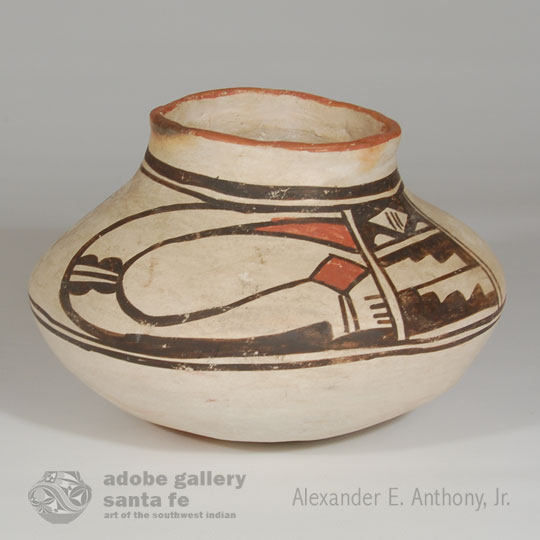 This historic small jar is one of Nampeyo's white-slip creations. These early jars by Nampeyo are often simple in design, as is this one. It is such simplicity that makes it so appealing. The thick framing line at the neck and the pair of thinner framing lines at the midpoint of the jar define the area of design. The long thin swirl lines on the slope of the neck are very typical of a design which Nampeyo continued to use later. The very minimum red slip in the design is indicative of her early work. The rim is red. The jar would date to 1880 or so.
This historic small jar is one of Nampeyo's white-slip creations. These early jars by Nampeyo are often simple in design, as is this one. It is such simplicity that makes it so appealing. The thick framing line at the neck and the pair of thinner framing lines at the midpoint of the jar define the area of design. The long thin swirl lines on the slope of the neck are very typical of a design which Nampeyo continued to use later. The very minimum red slip in the design is indicative of her early work. The rim is red. The jar would date to 1880 or so.
To purchase or read more click here.
#adobegallery #SouthwestIndianPottery #HopiPueblo #PuebloPottery #SantaFePottery #FinePuebloPottery #SantaFeNM # NampeyoOfHano
Hopi Wakas - Cow Katsina Doll with Fred Harvey Tag - C4045B
The Fred Harvey Company was the owner of the Harvey House chain of restaurants, hotels, gift shops and other hospitality industry businesses alongside railroads in the western United States. It was founded in 1876 by Fred Harvey to cater to the growing number of train passengers. When Harvey died in 1901, his family inherited 45 restaurants and 20 dining cars in 12 states.
For the Southwest, Harvey hired architects Charles Whittlesey and designer Mary Colter for influential landmark hotels in Santa Fe and Gallup, New Mexico. The Grand Canyon was the Santa Fe's main tourist destination and a major activity of the Harvey Company. Colter's rugged, landscape-integrated, and culturally appropriate design principles there influenced a generation of subsequent Western U.S. architecture through the National Park Service and Civilian Conservation Corps structures built during the Great Depression and after.
To purchase or read more - Click here..
#adobegallery #HopiPueblo #Katsina #Kachina #Doll #SouthwestIndianArt #PuebloArt #SantaFeNM
Santa Clara Pueblo Stone Polished Red Melon-ribbed Jar by Helen Shupla - C4047J
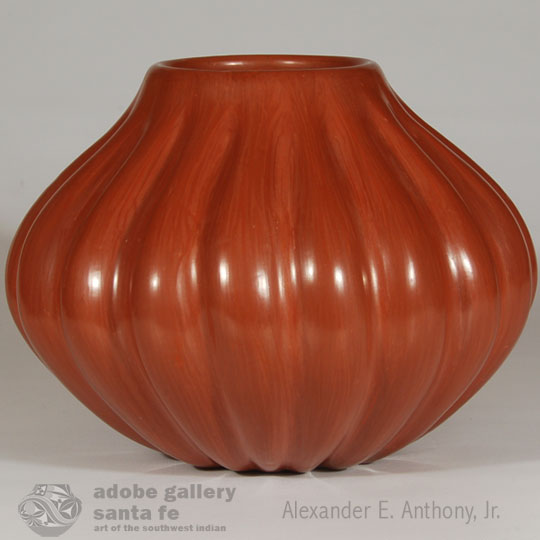 Helen Shupla was of Santa Clara Pueblo and Tohono O'odham tribal heritage. She was active as a potter from around the mid-1940s until her death in 1985. Her husband, Kenneth Shupla, was a Hopi katsina doll carver who moved to Santa Clara when he married. In pueblo culture, it is traditional for the husband to move to the wife's village. Their daughter married Alton Komalestewa, also a Hopi. He was mentored as a potter by Helen Shupla and began making melon jars of her pottery style.
Helen Shupla was of Santa Clara Pueblo and Tohono O'odham tribal heritage. She was active as a potter from around the mid-1940s until her death in 1985. Her husband, Kenneth Shupla, was a Hopi katsina doll carver who moved to Santa Clara when he married. In pueblo culture, it is traditional for the husband to move to the wife's village. Their daughter married Alton Komalestewa, also a Hopi. He was mentored as a potter by Helen Shupla and began making melon jars of her pottery style.
<!-- /* Font Definitions */ @font-face {font-family:Arial; panose-1:2 11 6 4 2 2 2 2 2 4; mso-font-charset:0; mso-generic-font-family:auto; mso-font-pitch:variable; mso-font-signature:-536859905 -1073711037 9 0 511 0;} @font-face {font-family:"Cambria Math"; panose-1:2 4 5 3 5 4 6 3 2 4; mso-font-charset:0; mso-generic-font-family:auto; mso-font-pitch:variable; mso-font-signature:-536870145 1107305727 0 0 415 0;} @font-face {font-family:Calibri; panose-1:2 15 5 2 2 2 4 3 2 4; mso-font-charset:0; mso-generic-font-family:auto; mso-font-pitch:variable; mso-font-signature:-536870145 1073786111 1 0 415 0;} /* Style Definitions */ p.MsoNormal, li.MsoNormal, div.MsoNormal {mso-style-unhide:no; mso-style-qformat:yes; mso-style-parent:""; margin:0in; margin-bottom:.0001pt; mso-pagination:widow-orphan; font-size:12.0pt; font-family:"Times New Roman"; mso-fareast-font-family:Calibri; mso-fareast-theme-font:minor-latin;} .MsoChpDefault {mso-style-type:export-only; mso-default-props:yes; font-size:11.0pt; mso-ansi-font-size:11.0pt; mso-bidi-font-size:11.0pt; font-family:Calibri; mso-ascii-font-family:Calibri; mso-ascii-theme-font:minor-latin; mso-fareast-font-family:Calibri; mso-fareast-theme-font:minor-latin; mso-hansi-font-family:Calibri; mso-hansi-theme-font:minor-latin; mso-bidi-font-family:"Times New Roman"; mso-bidi-theme-font:minor-bidi;} .MsoPapDefault {mso-style-type:export-only; margin-bottom:10.0pt; line-height:115%;} @page WordSection1 {size:8.5in 11.0in; margin:1.0in 1.0in 1.0in 1.0in; mso-header-margin:.5in; mso-footer-margin:.5in; mso-paper-source:0;} div.WordSection1 {page:WordSection1;} --> #adobegallery #SouthwestIndianPottery #SantaClaraPueblo #Historic #Pottery #SantaClaraPuebloPottery #SantaClaraPottery #PuebloPottery #HelenShupla
Hopi Pueblo Katsina Doll by Wilson Tawaquaptewa - C4045E
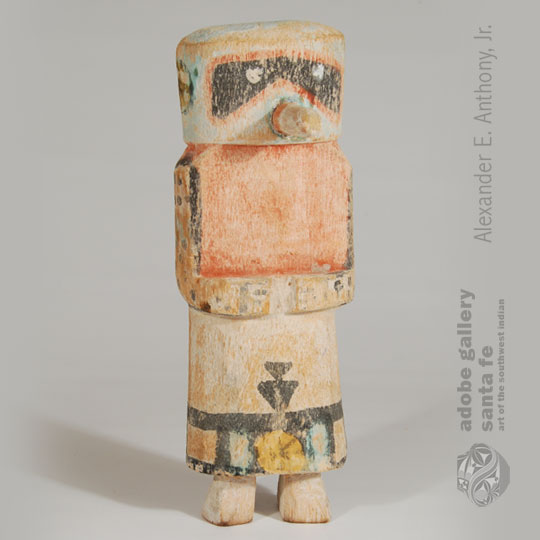
Wilson Tawaquaptewa is the earliest carver that we know by name and he created figures that were given to the children as well as pieces that he sold. His carving career spanned at least four decades.
Wilson Tawaquaptewa would unhesitatingly alter the iconography of a Katsina doll in subtle ways. All his carvings were beautifully made, and his style is quite identifiable, although it is sometimes difficult to determine which katsina he had in mind while carving. This was not by accident. As a religious leader at Hopi, he was not comfortable with selling authentic katsina dolls to tourists, so he made slight changes to the carvings. This satisfied his conflict with religion and sales and appeased the tourist who was unaware anyway.
#adobegallery #HopiPueblo #Katsina #Kachina #Doll #SouthwestIndianArt #PuebloArt #SantaFeNM #WilsonTawaquaptewa
Hopi Pueblo Poli Mana Katsina Doll from 1937 - C4045A
 As in many instances, there is a male and a female version of this katsina. The Polior Butterfly Katsina is the male and the Poli Mana is the female. They always appear together but only in the kiva during the Night Dance. In most instances, the male version of a katsina is better known than the female version, but in this instance, the female is better known, perhaps because of her elaborate face and headdress.
As in many instances, there is a male and a female version of this katsina. The Polior Butterfly Katsina is the male and the Poli Mana is the female. They always appear together but only in the kiva during the Night Dance. In most instances, the male version of a katsina is better known than the female version, but in this instance, the female is better known, perhaps because of her elaborate face and headdress.
According to Barton Wright "He (Poli) seems to appear solely on Third Mesa and may actually be a development of that Mesa. His partner (Poli Mana) looks almost exactly like the Palhik Mana but does not serve quite the same function. The female katsina partner is portrayed by a man unlike the regular Palhik Mana who is a woman. The steps and postures of the Poli Katsina and Mana, in fact the entire form of the dance, are very much like that of the more common social Butterfly Dance." Wright, 1973
Barton Wright further states that the katsina is a continuum, beginning with the Poli Mana at one end and finishing with the Hopi Salako Mana at the other. Somewhere in between lies the Palhik Mana. This hypothetical continuum relates only to appearance.
#adobegallery #HopiPueblo #Katsina #Kachina #Doll #SouthwestIndianArt #PuebloArt #SantaFeNM
Rare and Remarkable Katsina Dolls
Katsina dolls—colorful, elaborately decorated cottonwood carvings of Native American spirit beings—are more than beautiful works of art. They are educational tools created to teach young Hopi Indian women about their religion. By studying and collecting authentic Katsina dolls, outsiders are allowed and encouraged to learn about the rich cosmology of the Hopi people.
Adobe Gallery’s new exhibit “Rare and Remarkable Katsina Dolls” will open February 2, 2018 with reception from 5-7 pm. “Rare and Remarkable Katsina Dolls” will feature authentic Hopi Katsina dolls, the majority of which were completed in the traditional style. The exhibit, which will also include contemporary Hopi pieces and a select few pieces from Zuni Pueblo, will continue through March 2018. Click here to see the show now.
Gregory Schaaf stopped in to see our Special Exhbit opening on February 2, 2018.
Greg is holding his book: Hopi Katsina-1,600 Artist Biographies by Gregory and Angie Schaaf.
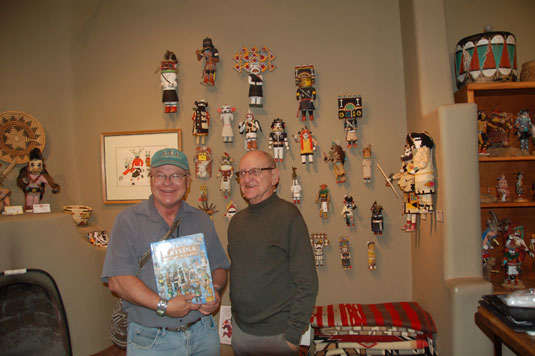
San Ildefonso Pueblo Eagle Dance Grouping Painting by Tonita Peña - C3875A
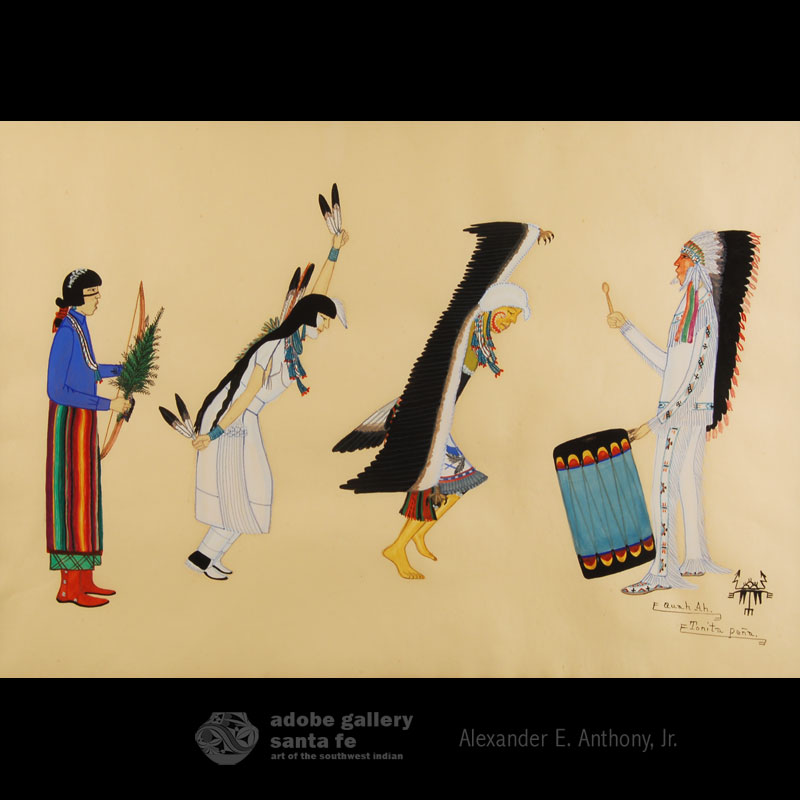 Tonita Peña, whose Tewa name was Quah Ah, was born in 1893 in the tiny New Mexico pueblo of San Ildefonso. The pueblo is located on the Rio Grande, just north of Santa Fe. At the age of 12, her mother passed away and her father, unable to raise her and tend his fields and pueblo responsibilities, took her to live with her aunt and uncle at Cochiti Pueblo. This was where she would spend the remainder of her life.
Tonita Peña, whose Tewa name was Quah Ah, was born in 1893 in the tiny New Mexico pueblo of San Ildefonso. The pueblo is located on the Rio Grande, just north of Santa Fe. At the age of 12, her mother passed away and her father, unable to raise her and tend his fields and pueblo responsibilities, took her to live with her aunt and uncle at Cochiti Pueblo. This was where she would spend the remainder of her life.
Tonita was the only woman in the group of talented early pueblo artists referred to as the San Ildefonso Self-Taught Group, which included such noted artists as Julian Martinez, Alfonso Roybal, Abel Sanchez, Crecencio Martinez, and Encarnación Peña.
Would you like to purchase or read more about this painting?
Historic Small Zuni Pueblo Polychrome Jar, circa 1880s - C3926E
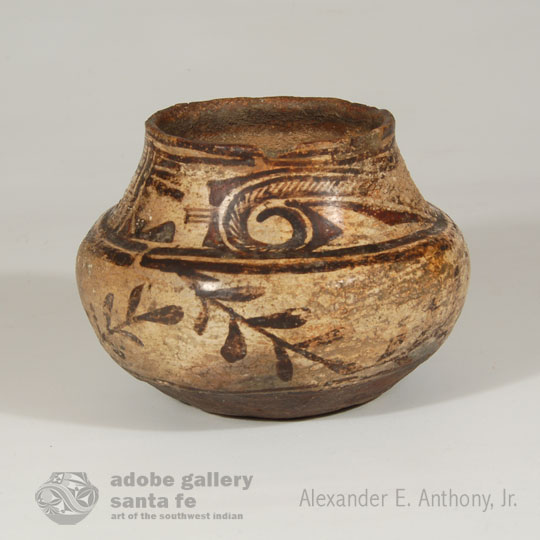 This small jar has all the attributes of its larger model. It has a puki impression line on the brown underbody, indicating that its start was in a small bowl. The underbody is concave. The body is very traditional in shape with a globular bulge, reversing to a curved neck and a slightly rolled out rim. We are dating this small jar circa 1880 due to its strong puki flexure and limited design typology.
This small jar has all the attributes of its larger model. It has a puki impression line on the brown underbody, indicating that its start was in a small bowl. The underbody is concave. The body is very traditional in shape with a globular bulge, reversing to a curved neck and a slightly rolled out rim. We are dating this small jar circa 1880 due to its strong puki flexure and limited design typology.
The pottery body designs are floral elements, enclosed above and below with framing lines. The framing lines at the shoulder are wide and split with a ceremonial line break. The lower framing line is slimmer. There is a pair of framing lines just below the rim. The design on the neck is very traditionally Zuni in style-hook with fine lines and arrowhead with parallel lines.
Would you like to purchase or read more about this Zuni pottery?
Historic Zuni Pueblo Traditional Heartline Deer Olla - C3973B
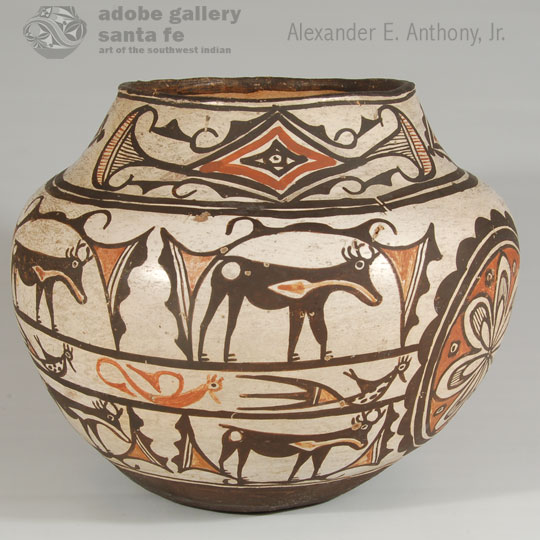 This very finely made vessel appears to date to the first quarter of the 20th century. It is a medium-size jar, smaller than the typical water jar.
This very finely made vessel appears to date to the first quarter of the 20th century. It is a medium-size jar, smaller than the typical water jar.
It is undeniably Zuni in form, design, materials and character, and is an intriguing and typical example of Zuni artistry. The paste is typically Zuni, gray in color with a chunky texture, the temper being ground pottery shards. The underbody and neck interior are black-slipped, with white stone-polished slip on the exterior body.
Would you like to purchase or read more about this historic Pueblo pottery?
Navajo Transitional Third Phase Chief Blanket - C3969H
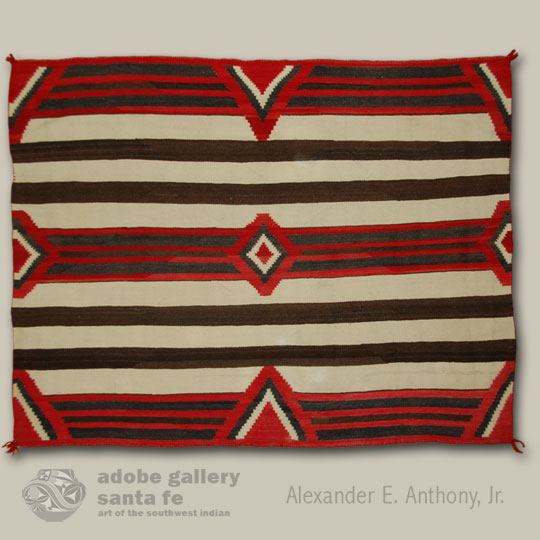 There was a period between the end of the classic phase of weaving and the complete introduction of rug size textiles that is known as the transitional period. This was the period when weavers were transitioning from what they were used to making, to making what the traders wanted. This period is described as occurring between 1880 and 1920.
There was a period between the end of the classic phase of weaving and the complete introduction of rug size textiles that is known as the transitional period. This was the period when weavers were transitioning from what they were used to making, to making what the traders wanted. This period is described as occurring between 1880 and 1920.
During the transitional period, Third Phase Chief Blankets were woven in the traditional pattern but in larger sizes-a size suitable for use on the floor or displayed on the wall, but too large to be worn as a blanket. That is what this Third Phase textile represents. It is probably from the very early 1900s, is of blanket quality, but too large to serve as a wearing blanket. It was woven from churro wool with the only dye being an aniline red.
Would you like to purchase or read more about this Chief blanket?
Navajo Wool Textile of a Single Figure Yei Rug - C3969G
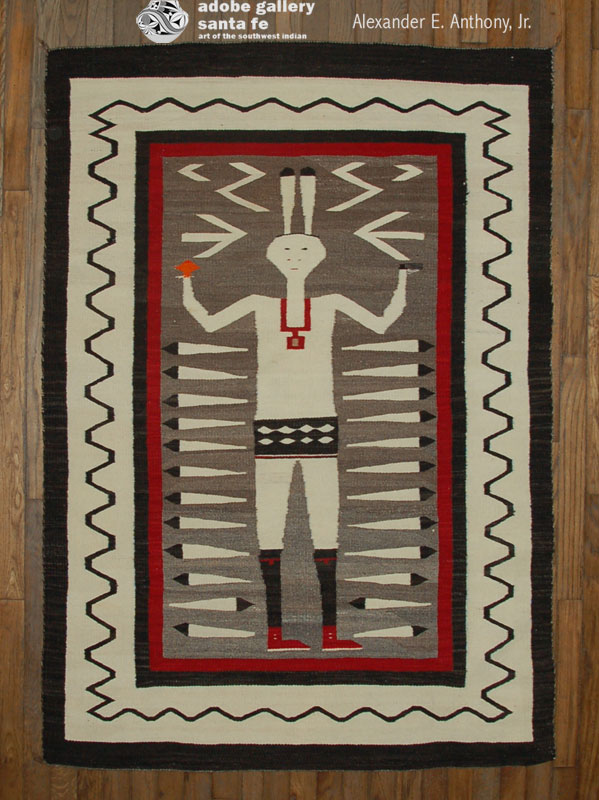 A Yei (pronounced "yay") is a spirit being of the Navajo (Diné) people. Yei are summoned by medicine men during Navajo healing ceremonies. The medicine man will create a dry painting to recreate specific stories which, along with songs, aid the patient in the healing process, to bring him or her back to harmony. The paintings are intricate, and for the ceremony to be successful, everything must be executed precisely. It can take years to learn the proper songs and the corresponding paintings that ensure harmony for the patient. The correct depiction of the Yei are essential components of the ceremony.
A Yei (pronounced "yay") is a spirit being of the Navajo (Diné) people. Yei are summoned by medicine men during Navajo healing ceremonies. The medicine man will create a dry painting to recreate specific stories which, along with songs, aid the patient in the healing process, to bring him or her back to harmony. The paintings are intricate, and for the ceremony to be successful, everything must be executed precisely. It can take years to learn the proper songs and the corresponding paintings that ensure harmony for the patient. The correct depiction of the Yei are essential components of the ceremony.
In the early 20th century, trading posts came into prominence on the Navajo reservation. The traders at individual posts promoted certain textile styles and patterns which they encouraged the weavers in their area to weave. Trader Will Evans at the Shiprock Trading Company fostered and marketed the pictorial designs which included Yei. Although Yei are religious beings from Navajo ceremonies, the weavings themselves have no religious significance. These rugs require a high degree of technical skill to weave and only the very best weavers could accomplish the task of creating a pictorial Yei weaving.
Would you like to purchase or read more about this rug?
Taos Pueblo Original Painting “Blue Fawn” by Eva Mirabal - C3982D
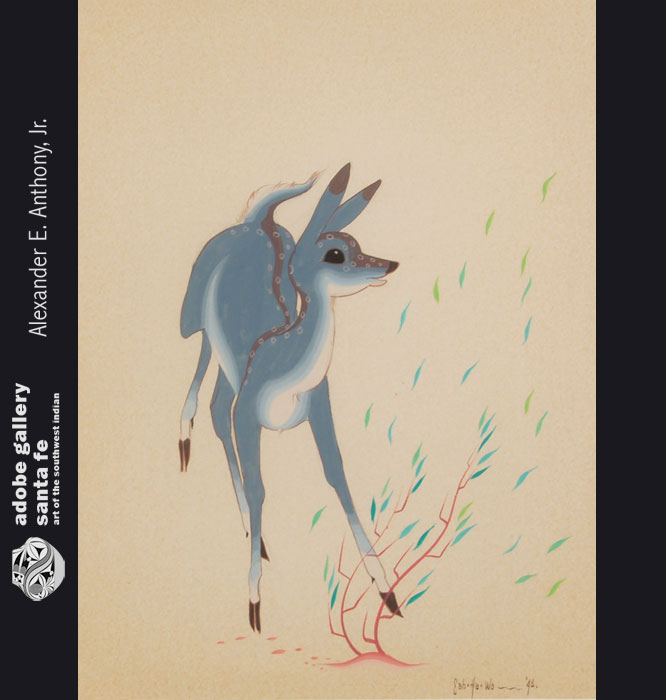 This painting was completed by Eva Mirabal in 1948. She titled it "Blue Fawn" and it was painted as a companion to one she titled "Leaping Fawn" which is our Item Number C3982E (click here to view now). Both paintings were painted on beige paper and colors chosen were pastel in tone.
This painting was completed by Eva Mirabal in 1948. She titled it "Blue Fawn" and it was painted as a companion to one she titled "Leaping Fawn" which is our Item Number C3982E (click here to view now). Both paintings were painted on beige paper and colors chosen were pastel in tone.
She favored painting small paintings, usually of a single figure, depicting traditional activities in and around Taos Pueblo where she had been born and where she lived most of her life. She had studied at the Santa Fe Indian School under Dorothy Dunn, at the University of Southern Illinois, Carbondale, and at the Taos Valley Art School, Taos, New Mexico.
Would you like to purchase or read more about this painting?
Taos Pueblo Original Painting “Fleeing Fawn” by Eva Mirabal - C3982E
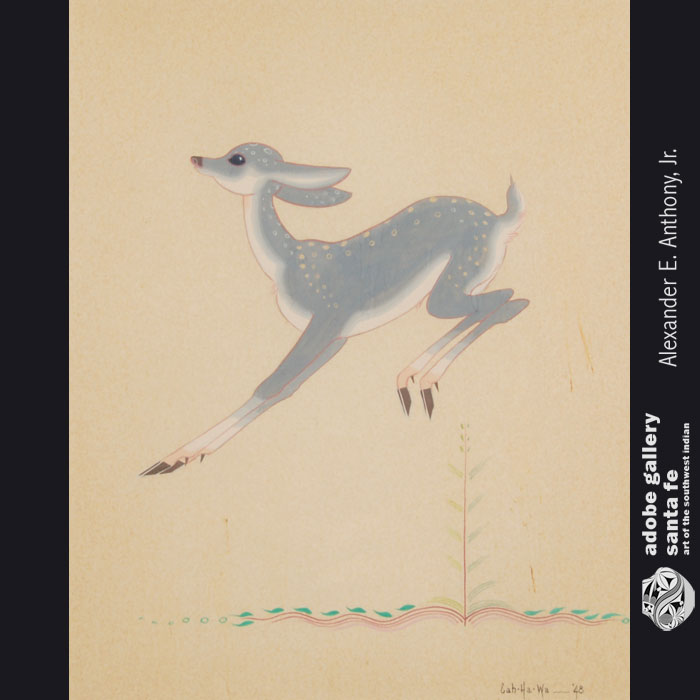 This painting was completed by Eva Mirabal in 1948. She titled it "Leaping Fawn" and it was painted as a companion to one she titled "Blue Fawn" which is our Item Number C3982D (click here to view now). Both paintings were painted on beige paper and colors chosen were pastel in tone.
This painting was completed by Eva Mirabal in 1948. She titled it "Leaping Fawn" and it was painted as a companion to one she titled "Blue Fawn" which is our Item Number C3982D (click here to view now). Both paintings were painted on beige paper and colors chosen were pastel in tone.
She favored painting small paintings, usually of a single figure, depicting traditional activities in and around Taos Pueblo where she had been born and where she lived most of her life. She had studied at the Santa Fe Indian School under Dorothy Dunn, at the University of Southern Illinois University at Carbondale, and at the Taos Valley Art School, Taos, New Mexico.
Would you like to purchase or read more about this painting?
Three Deer with Santo Domingo Pottery Designs by Charles Lovato - C3963B
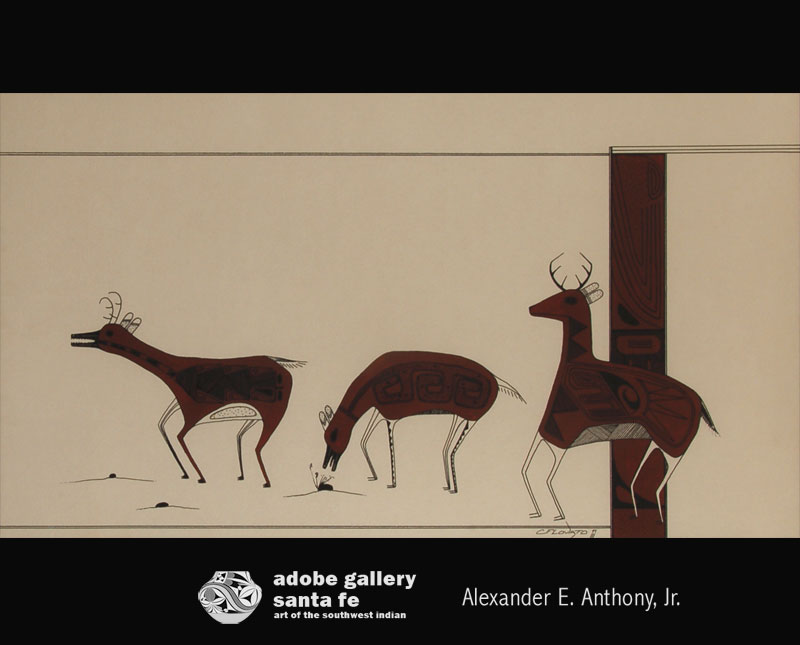 Kewa Pueblo (Santo Domingo) is known mostly for its fine heishi jewelry and beautiful pottery. There are few painters from the Pueblo. Charles Lovato is probably the finest and most recognized painter from Kewa. He was a poet and a jeweler as well as a painter.
Kewa Pueblo (Santo Domingo) is known mostly for its fine heishi jewelry and beautiful pottery. There are few painters from the Pueblo. Charles Lovato is probably the finest and most recognized painter from Kewa. He was a poet and a jeweler as well as a painter.
Lovato's paintings are a modern testimony to his pueblo ancestors. His work is uniquely abstract. In this painting of three deer grazing, he has placed ancient pottery designs within each deer. It is no surprise that Lovato incorporated pottery designs into his work, as he was raised by his grandmother, Monica Silva, who was considered to be one of the most talented potters at Kewa.
Would you like to buy or read more about this painting?
Hopi Pueblo Polychrome Jar with Lid by Daisy Nampeyo - C3975C
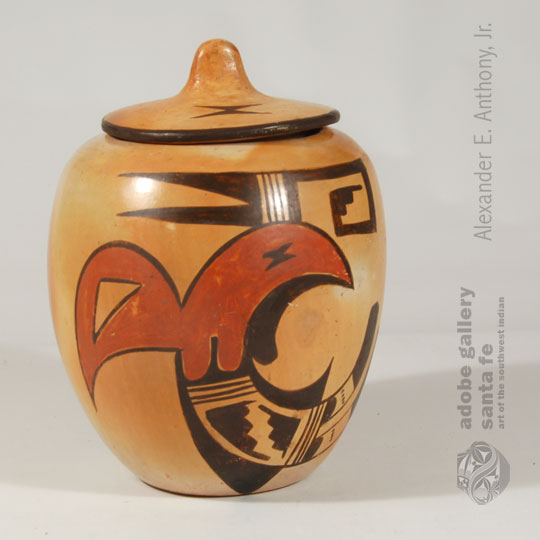 Daisy Hooee Nampeyo was the granddaughter of Nampeyo of Hano and the daughter of Willie and Annie Healing. She was born into the Corn Clan of her mother but was named Tobacco Flower after the Tobacco Clan of her father. The name, Daisy, was given to her by a field nurse at the government agency on First Mesa. Although she was born at Hano, the family moved to a new village called Polacca at the base of First Mesa.
Daisy Hooee Nampeyo was the granddaughter of Nampeyo of Hano and the daughter of Willie and Annie Healing. She was born into the Corn Clan of her mother but was named Tobacco Flower after the Tobacco Clan of her father. The name, Daisy, was given to her by a field nurse at the government agency on First Mesa. Although she was born at Hano, the family moved to a new village called Polacca at the base of First Mesa.
Daisy spent many of her formative years with her grandmother and learned how to make pottery at a very early age. Like many starting potters, her early pottery was not the best but she had an excellent teacher in Nampeyo and soon began to create wonderful pieces and used designs from pottery shards she found at Sikyatki.
Hopi Pueblo Tall and Slim Black-on-red Cylinder Jar - C3974B
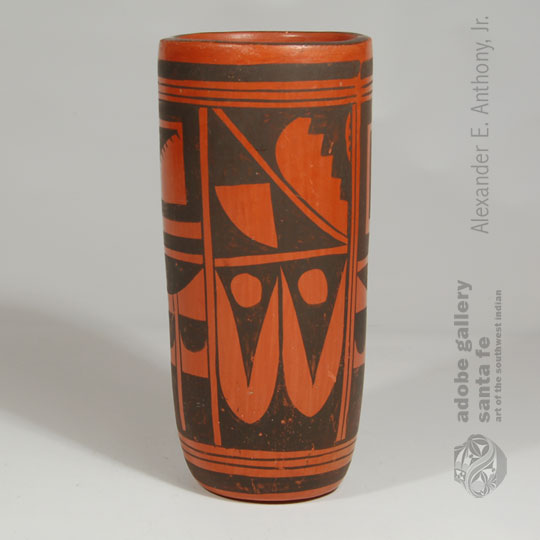 It is generally accepted that prehistoric cylindrical jars existed at some New Mexico pueblo sites and that they were used as drinking containers for chocolate. There is no such history associated with the potters at Hopi. It has been speculated that cylindrical jars were made by request of Thomas V. Keam as a suitable item for the tourist trade. If this is true, then they were probably made as early as the 1880s.
It is generally accepted that prehistoric cylindrical jars existed at some New Mexico pueblo sites and that they were used as drinking containers for chocolate. There is no such history associated with the potters at Hopi. It has been speculated that cylindrical jars were made by request of Thomas V. Keam as a suitable item for the tourist trade. If this is true, then they were probably made as early as the 1880s.
The age of this one is not known but it probably predates the mid-20th century, an assumption made because it does not reflect the name of the potter.
Would you like to purchase or read more about this Hopi pottery?
Historic Zia Pueblo Small Olla with Trios Polychrome Design - C3969C
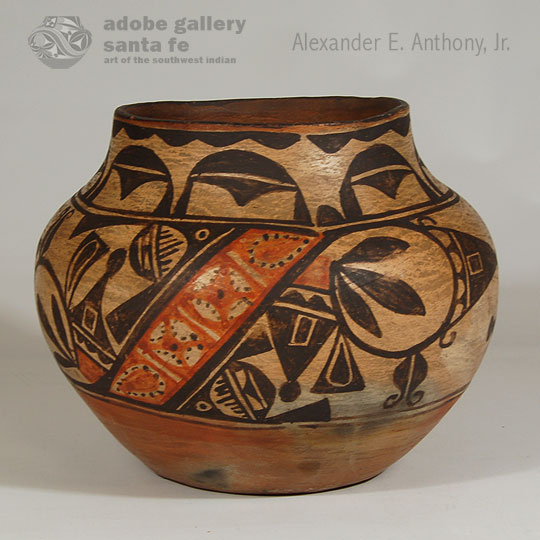 This jar combines the best qualities of Zia Polychrome with the finest design of the Trios Polychrome. It has two rectangular bands executed in red slip. The vessel shape and black rim would indicate the later date, so we have chosen to say it is a Zia Polychrome jar with a Trios Polychrome design and would date to 1890-1910.
This jar combines the best qualities of Zia Polychrome with the finest design of the Trios Polychrome. It has two rectangular bands executed in red slip. The vessel shape and black rim would indicate the later date, so we have chosen to say it is a Zia Polychrome jar with a Trios Polychrome design and would date to 1890-1910.
The designs associated with the Trios period are some of the most elegant and beautiful designs applied to pottery during the later Zia period. We are fortunate that some potters who were experienced with the Trios design continued producing it into the later period. The design is a very rich dark brown on cream slip, and repeated only twice around the vessel body.
Would you like to purchase or read more about this Zia Pueblo Pottery?
Hopi Pueblo Six-Sided Four-Directional Pottery Tile by Mark Tahbo - 26013
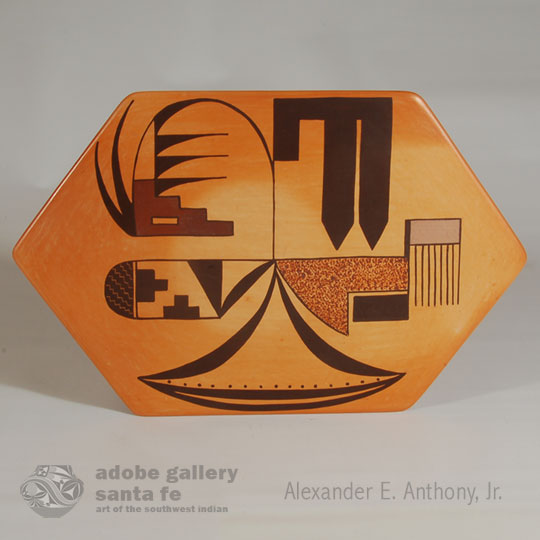 The design can easily be viewed as having four distinct quadrants. It may be viewed in any rotation as there is no correct up and down. If the twin towers are arranged to be in the lower left, then there is an abstract bird in lower right, a tubular design with squiggles under the dome, a geometric design in upper left where the grey rectangle sprouts parallel linear lines, and the whole tile under what may appear to be a cloud with drops of rain ready to fall.
The design can easily be viewed as having four distinct quadrants. It may be viewed in any rotation as there is no correct up and down. If the twin towers are arranged to be in the lower left, then there is an abstract bird in lower right, a tubular design with squiggles under the dome, a geometric design in upper left where the grey rectangle sprouts parallel linear lines, and the whole tile under what may appear to be a cloud with drops of rain ready to fall.
Would you like to purchase or read more about this Mark Tahbo pottery?

